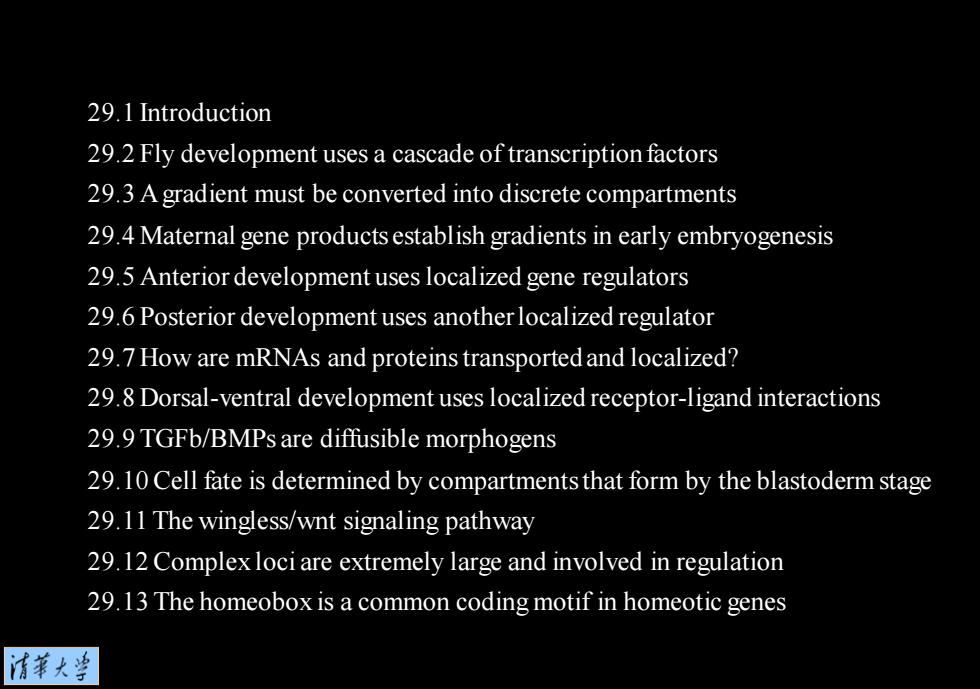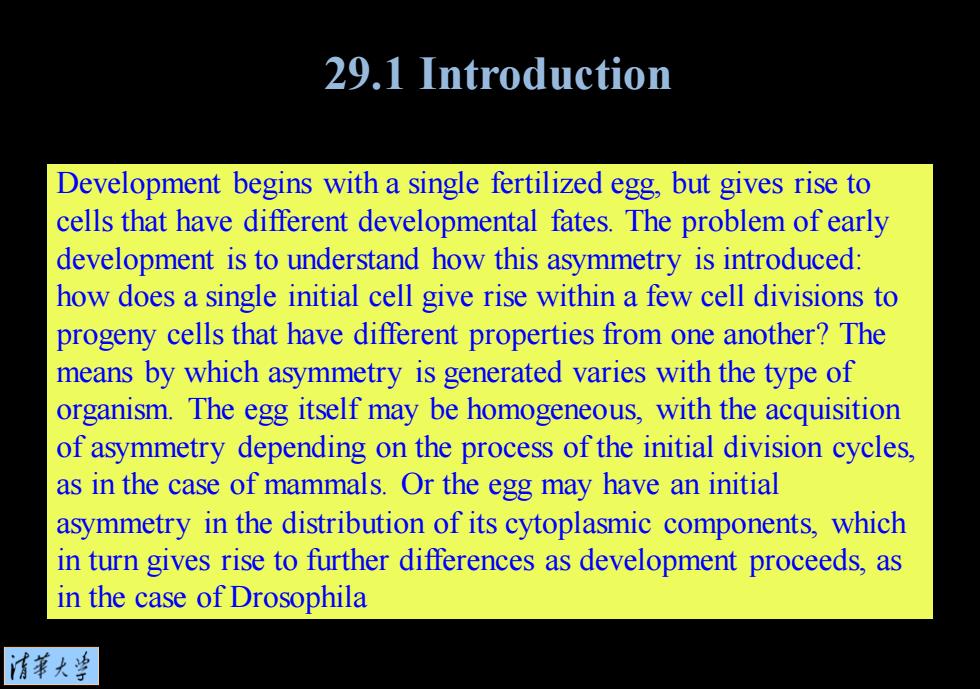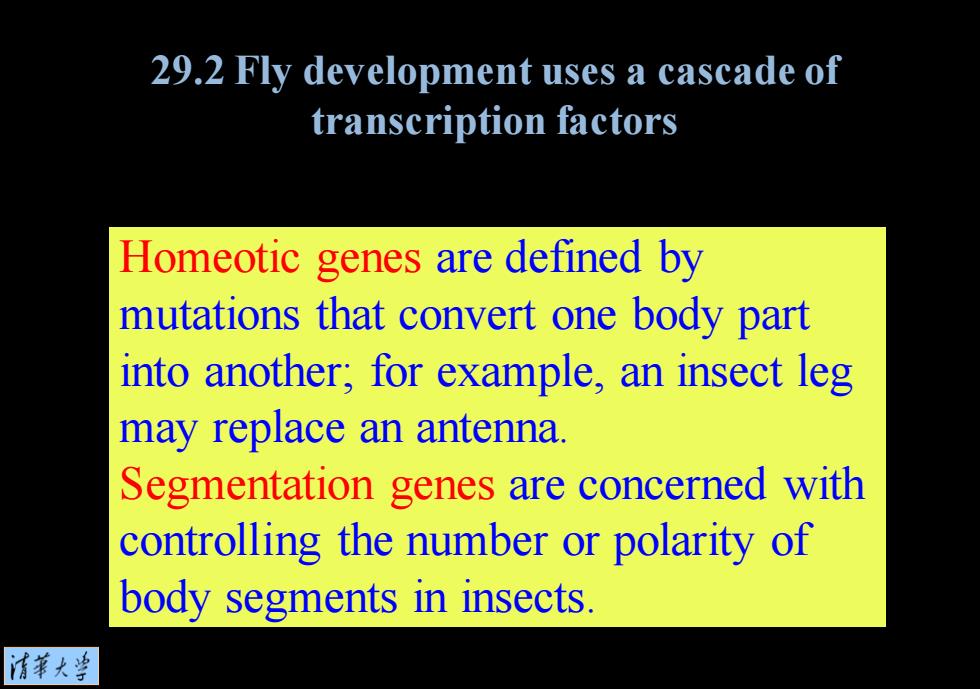
Chapter 29 Gradients,cascades, and signaling pathways 清苇大当
Chapter 29 Gradients, cascades, and signaling pathways

29.1 Introduction 29.2 Fly development uses a cascade of transcription factors 29.3 A gradient must be converted into discrete compartments 29.4 Maternal gene products establish gradients in early embryogenesis 29.5 Anterior development uses localized gene regulators 29.6 Posterior development uses another localized regulator 29.7 How are mRNAs and proteins transported and localized? 29.8 Dorsal-ventral development uses localized receptor-ligand interactions 29.9 TGFb/BMPs are diffusible morphogens 29.10 Cell fate is determined by compartments that form by the blastoderm stage 29.11 The wingless/wnt signaling pathway 29.12 Complex loci are extremely large and involved in regulation 29.13 The homeobox is a common coding motif in homeotic genes 清苇大兰
29.1 Introduction 29.2 Fly development uses a cascade of transcription factors 29.3 A gradient must be converted into discrete compartments 29.4 Maternal gene products establish gradients in early embryogenesis 29.5 Anterior development uses localized gene regulators 29.6 Posterior development uses another localized regulator 29.7 How are mRNAs and proteins transported and localized? 29.8 Dorsal-ventral development uses localized receptor-ligand interactions 29.9 TGFb/BMPs are diffusible morphogens 29.10 Cell fate is determined by compartments that form by the blastoderm stage 29.11 The wingless/wnt signaling pathway 29.12 Complex loci are extremely large and involved in regulation 29.13 The homeobox is a common coding motif in homeotic genes

29.1 Introduction Development begins with a single fertilized egg,but gives rise to cells that have different developmental fates.The problem of early development is to understand how this asymmetry is introduced: how does a single initial cell give rise within a few cell divisions to progeny cells that have different properties from one another?The means by which asymmetry is generated varies with the type of organism.The egg itself may be homogeneous,with the acquisition of asymmetry depending on the process of the initial division cycles, as in the case of mammals.Or the egg may have an initial asymmetry in the distribution of its cytoplasmic components,which in turn gives rise to further differences as development proceeds,as in the case of Drosophila 情華大当
Development begins with a single fertilized egg, but gives rise to cells that have different developmental fates. The problem of early development is to understand how this asymmetry is introduced: how does a single initial cell give rise within a few cell divisions to progeny cells that have different properties from one another? The means by which asymmetry is generated varies with the type of organism. The egg itself may be homogeneous, with the acquisition of asymmetry depending on the process of the initial division cycles, as in the case of mammals. Or the egg may have an initial asymmetry in the distribution of its cytoplasmic components, which in turn gives rise to further differences as development proceeds, as in the case of Drosophila 29.1 Introduction

29.1 Introduction Development begins with a single fertilized egg,but gives rise to cells that have different developmental fates.The problem of early development is to understand how this asymmetry is introduced: how does a single initial cell give rise within a few cell divisions to progeny cells that have different properties from one another?The means by which asymmetry is generated varies with the type of organism.The egg itself may be homogeneous,with the acquisition of asymmetry depending on the process of the initial division cycles, as in the case of mammals.Or the egg may have an initial asymmetry in the distribution of its cytoplasmic components,which in turn gives rise to further differences as development proceeds,as in the case of Drosophila 清菜大当
Development begins with a single fertilized egg, but gives rise to cells that have different developmental fates. The problem of early development is to understand how this asymmetry is introduced: how does a single initial cell give rise within a few cell divisions to progeny cells that have different properties from one another? The means by which asymmetry is generated varies with the type of organism. The egg itself may be homogeneous, with the acquisition of asymmetry depending on the process of the initial division cycles, as in the case of mammals. Or the egg may have an initial asymmetry in the distribution of its cytoplasmic components, which in turn gives rise to further differences as development proceeds, as in the case of Drosophila 29.1 Introduction

29.2 Fly development uses a cascade of transcription factors Homeotic genes are defined by mutations that convert one body part into another;for example,an insect leg may replace an antenna. Segmentation genes are concerned with controlling the number or polarity of body segments in insects. 情菜大当
Homeotic genes are defined by mutations that convert one body part into another; for example, an insect leg may replace an antenna. Segmentation genes are concerned with controlling the number or polarity of body segments in insects. 29.2 Fly development uses a cascade of transcription factors